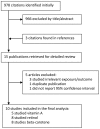Vitamin A intake and risk of melanoma: a meta-analysis
- PMID: 25048246
- PMCID: PMC4105469
- DOI: 10.1371/journal.pone.0102527
Vitamin A intake and risk of melanoma: a meta-analysis
Abstract
Background: Mounting evidence from experimental and animal studies suggests that vitamin A may have a protective effect on melanoma, but the findings on the association of vitamin A intake with risk of melanoma have been inconsistently reported in epidemiologic studies. We attempted to elucidate the association by performing a meta-analysis.
Methods: Eligible studies were identified by searching PubMed and EMBASE databases, as well as by reviewing the references of retrieved publications. Summary odds ratios (OR) with corresponding 95% confidence interval (CI) were computed with a random-effects model. Study-specific ORs and 95% CIs for the highest vs. lowest categories of vitamin A intake were pooled.
Results: A total of 8 case-control studies and 2 prospective studies comprising 3,328 melanoma cases and 233,295 non-case subjects were included. The summary OR for the highest compared with the lowest intake of total vitamin A, retinol and beta-carotene was 0.86 (95% CI = 0.59-1.25), 0.80 (95% CI = 0.69-0.92) and 0.87 (95%CI = 0.62-1.20), respectively. Significant heterogeneity was observed among studies on vitamin A and beta-carotene intake, but not among studies on retinol intake. Subgroup and sensitivity analyses confirmed these findings. There was no indication of publication bias.
Conclusion: Findings from this meta-analysis suggest that intake of retinol, rather than of total vitamin A or beta-carotene, is significantly associated with reduced risk of melanoma.
Conflict of interest statement
Figures




Similar articles
-
Association of vitamin A and β-carotene with risk for age-related cataract: a meta-analysis.Nutrition. 2014 Oct;30(10):1113-21. doi: 10.1016/j.nut.2014.02.025. Epub 2014 Mar 12. Nutrition. 2014. PMID: 25194611
-
Association between vitamin A, retinol and carotenoid intake and pancreatic cancer risk: Evidence from epidemiologic studies.Sci Rep. 2016 Dec 12;6:38936. doi: 10.1038/srep38936. Sci Rep. 2016. PMID: 27941847 Free PMC article.
-
A systematic review and meta-analysis of the association between vitamin A intake, serum vitamin A, and risk of liver cancer.Nutr Health. 2018 Jun;24(2):121-131. doi: 10.1177/0260106018777170. Epub 2018 May 23. Nutr Health. 2018. PMID: 29792083
-
Vitamins C and E, retinol, beta-carotene and dietary fibre in relation to breast cancer risk: a prospective cohort study.Br J Cancer. 1997;75(1):149-55. doi: 10.1038/bjc.1997.25. Br J Cancer. 1997. PMID: 9000614 Free PMC article.
-
Vitamin A and Breast Cancer Survival: A Systematic Review and Meta-analysis.Clin Breast Cancer. 2018 Dec;18(6):e1389-e1400. doi: 10.1016/j.clbc.2018.07.025. Epub 2018 Aug 4. Clin Breast Cancer. 2018. PMID: 30190194
Cited by
-
Exploring Potential Therapeutic Applications of Tazarotene: Gene Regulation Mechanisms and Effects on Melanoma Cell Growth.Curr Issues Mol Biol. 2025 Mar 28;47(4):237. doi: 10.3390/cimb47040237. Curr Issues Mol Biol. 2025. PMID: 40699636 Free PMC article. Review.
-
Dietary compounds and cutaneous malignant melanoma: recent advances from a biological perspective.Nutr Metab (Lond). 2019 May 21;16:33. doi: 10.1186/s12986-019-0365-4. eCollection 2019. Nutr Metab (Lond). 2019. PMID: 31139235 Free PMC article. Review.
-
Nutritional Interventions for Patients with Melanoma: From Prevention to Therapy-An Update.Nutrients. 2021 Nov 11;13(11):4018. doi: 10.3390/nu13114018. Nutrients. 2021. PMID: 34836273 Free PMC article. Review.
-
Coffee consumption and the risk of cutaneous melanoma: a meta-analysis.Eur J Nutr. 2016 Jun;55(4):1317-29. doi: 10.1007/s00394-015-1139-z. Epub 2015 Dec 22. Eur J Nutr. 2016. PMID: 26695410 Review.
-
NRF2 and Key Transcriptional Targets in Melanoma Redox Manipulation.Cancers (Basel). 2022 Mar 16;14(6):1531. doi: 10.3390/cancers14061531. Cancers (Basel). 2022. PMID: 35326683 Free PMC article. Review.
References
-
- Jemal A, Siegel R, Ward E, Hao Y, Xu J, et al. (2009) Cancer statistics, 2009. CA: a cancer journal for clinicians 59: 225–249. - PubMed
-
- Dennis LK (1999) Analysis of the melanoma epidemic, both apparent and real: data from the 1973 through 1994 surveillance, epidemiology, and end results program registry. Arch Dermatol 135: 275–280. - PubMed
-
- de Vries E, Coebergh JW (2004) Cutaneous malignant melanoma in Europe. European journal of cancer (Oxford, England: 1990) 40: 2355. - PubMed
-
- Gandini S, Sera F, Cattaruzza MS, Pasquini P, Picconi O, et al. (2005) Meta-analysis of risk factors for cutaneous melanoma: II. Sun exposure. European Journal of Cancer 41: 45–60. - PubMed
-
- Gandini S, Sera F, Cattaruzza MS, Pasquini P, Abeni D, et al. (2005) Meta-analysis of risk factors for cutaneous melanoma: I. Common and atypical naevi. European Journal of Cancer 41: 28–44. - PubMed
Publication types
MeSH terms
Substances
LinkOut - more resources
Full Text Sources
Other Literature Sources
Medical

